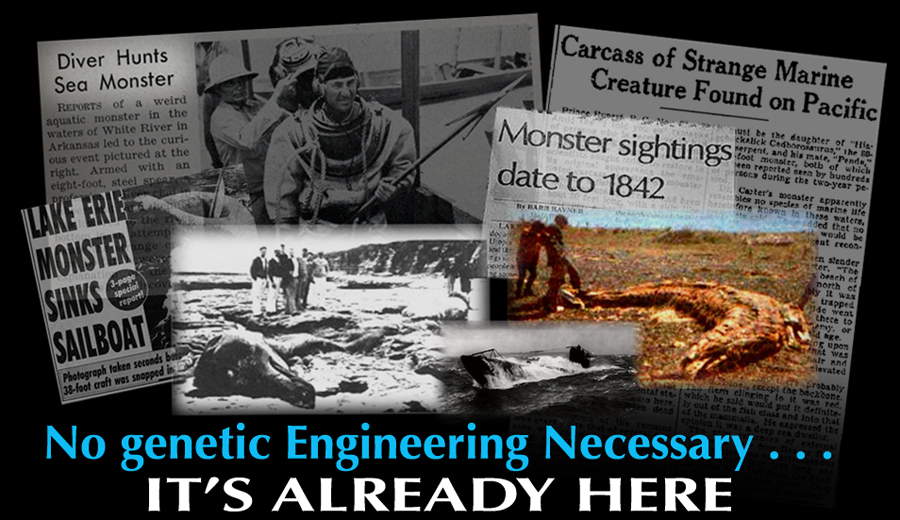
These days, trekking through the jungle, no one fears bumping into a living dinosaur, but out on the open ocean, where over 90% of the deep sea floor remains unexplored, you never know––and that’s what makes Vengeance so terrifying. This is not a tale of fictitious dinosaurs created in a laboratory.
Pliosaurs died out with the dinosaurs 65 million years ago . . . supposedly. Throughout the world’s oceans there have been thousands of plesiosaur and pliosaur sightings. Many of these sightings were used in and helped inspire Vengeance From The Deep. The following are just a few examples.
The Gambian Sea Monster, South Africa – June 12, 1983

On June 12, 1983, wildlife enthusiast Owen Burnham, who has spent much of his life in West Africa, and is very familiar with its wildlife, discovered (in the presence of some members of his family) a very remarkable carcass on Gambia’s Bungalow Beach. It measured 15-16 ft. long, had black upperparts and much paler underparts, a long pair of jaws containing 80 teeth, a pair of nostrils at the tip of the upper jaw, and two pairs of flippers. As whales and dolphins have dorsal blowholes rather than terminal nostrils, and only a front pair of flippers (they lost their hind pair during evolution), it could not have been any modern-day form of cetacean. What was truly exceptional concerning this carcass, however, was that it had not begun to decompose externally. Indeed, except for the fact that one hind flipper had almost been torn away, there was no outward sign of damage to it.
Owen Burnham has since corresponded with the present author in detail regarding this case, providing a great amount of information. The remarkable fact that emerges is that only two types of animal resemble the carcass he saw–both of which officially died out more than 60 million years ago! One is a pliosaur–a short-necked form of plesiosaur; the other is a sea crocodile or thallatosuchian. As Owen Burnham is an extremely reliable, knowledgeable eyewitness, and was not alone when he encountered and examined the carcass, the case of the Gambian sea serpent would seem to offer some of the most provocative evidence currently available in support of the scientifically undiscovered, modern-day existence of one group of prehistoric reptiles!
Unfortunately locals took the head and buried the rest of the body in the sand before Scientists could examine the carcass further!
source – http://www.strangemag.com/seaserpcarcsshuk.html
source – http://supernaturalpursuits.co.uk/awesome-sea-monsters/
The UB-85 Attack – April 30, 1918
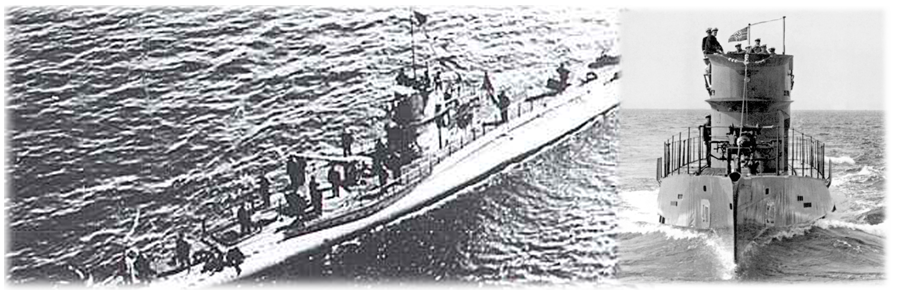
On April 30, 1918, the waning days of World War 1, the British patrol ship Coreopsis, while sailing off the Belfast Lough in Ireland, came upon a disabled German submarine, the UB-85, floating on the surface of the North Atlantic. The crewmembers of the Coreopsis were stunned by their discovery as they did not often come upon non aggressive German U Boats, especially not in the middle of the day.
The crew of the UB-85 was picked up by the Coreopsis after they abandoned ship with no provocation. Once on board the British patrol ship, the UB-85’s commander, Captain Gunther Krech, was interrogated immediately. One of the first questions asked by the British officers conducting the interrogation regarded the decision to remain on the surface even after the obviously British Coreopsis came within the UB-85’s line of sight.
According to Captain Krech, his U Boat surfaced the night before in order to recharge the submarine’s batteries. Krech was on deck with some men and a few of his officers, getting some fresh air and having a smoke, when an abrupt surge rocked the ship and a heavy weight seemed to bring down the starboard bow. Out of the darkness of the night, what the captain referred to as, a strange beast climbed out of the ocean and onto the side of the U Boat. The following is the description of the beast as told by Captain Krech to his British captors:
“This beast had large eyes, set in a horny sort of skull. It had a small head, but with teeth that could be seen glistening in the moonlight. Every man on watch began firing a sidearm at the beast, but the animal had hold of the forward gun mount and refused to let go.”
Captain Krech continued, stating the proportions of the beast were so immense that it rocked the U Boat and caused it to list greatly to the starboard side. Fearing that the ships open hatch would dip below the water line, which would subsequently flood the U Boat and sink it, Captain Krech ordered his men to continue their barrage. The crew continued firing upon the beast until it finally released the forward guns and disappeared back into the night blackened ocean.
Krech noted that during the struggle the forward deck plating of the UB-85 had been damaged rendering the U Boat incapable of submerging, the reason why the Coreopsis was able to catch the UB-85 at the surface. The crew’s retelling of the encounter, along with that of the captain’s, was chronicled by members of the British Navy only hours after the U Boat was found. The UB-85 was then cleared of any remaining crew that may have remained on board and sunk by the Coreopsis.
Today there remains no explanation that would adequately explain the events which resulted in the sinking of the UB-85 and the capture of her crew.
Source – http://www.unknownexplorers.com/beastofub85.php
U-28 ABOMINATION: (ATLANTIC OCEAN) – July 30, 1915
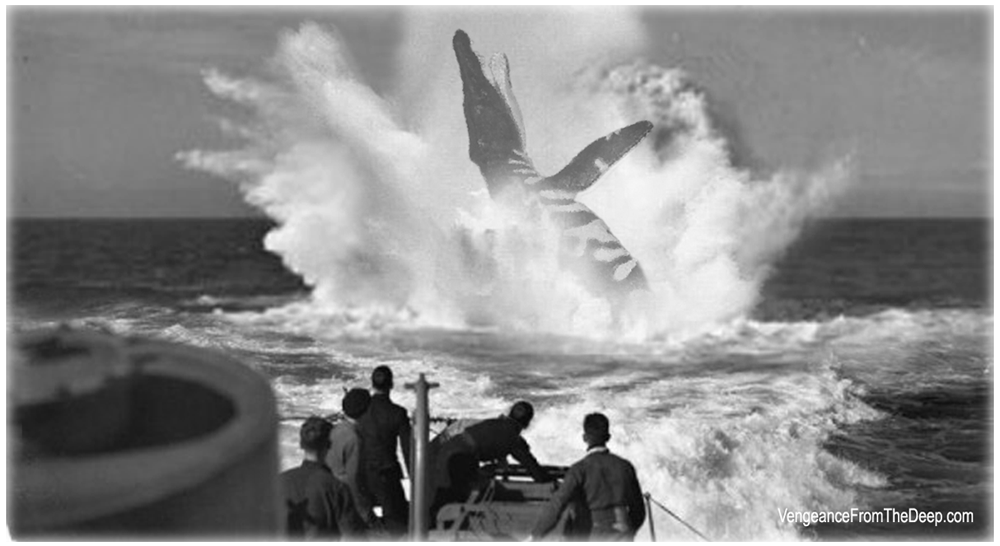
One of the most fascinating reports of an unusual, maritime encounter comes to us from the father cryptozoology himself, BERNARD HEUVELMANS, in his inestimable tome on the monstrous mysteries of the deep “In the Wake of the Sea Serpents.”
In the book Heuvelmans chronicles an account, which allegedly hailed from a German Baron — and former U-boat skipper — who, in 1933, told of his terrifying encounter with a SEA MONSTER during the early portion of WWI. Much like the incident reported by the UB-85 on April 30, 1918, the crew of the U-28 was given a rare glimpse into what one must assume to be a primeval world hidden beneath the ocean’s vast depths.
According to the report, following a military engagement with the British steamer Iberian off the southwest coast of Ireland — an encounter which tragically resulted in the steamer’s destruction via German torpedo and the deaths of all but 61 crew members — the captain and officers of the U-28 Schmidt bore witness to a spectacle which none of them could have anticipated. The Captain of the submarine, Commander Freiherr Georg-Günther von Forstner, described the encounter thusly:
“On July 30, 1915, our U-28 torpedoed the British steamer Iberian, which was carrying a rich cargo (trucks and jeeps primarily) across the North Atlantic. The steamer sank so swiftly that its bow stuck up almost vertically into the air. Moments later the hull of the Iberian disappeared.”
“The wreckage remained beneath the water for approximately twenty-five seconds, at a depth that was clearly impossible to assess, when suddenly there was a violent explosion, which shot pieces of debris — among them a gigantic aquatic animal — out of the water to a height of approximately 80-feet.”
“At that moment I had with me in the conning tower six of my officers of the watch, including the chief engineer, the navigator, and the helmsman. Simultaneously we all drew one another’s attention to this wonder of the seas, which was writhing and struggling among the debris.”
“We were unable to identify the creature, but all of us agreed that it resembled an aquatic crocodile, which was about 60-feet long, with four limbs resembling large webbed feet, a long, pointed tail and a head which also tapered to a point. Unfortunately we were not able to take a photograph, for the animal sank out of sight after ten or fifteen seconds.”
Submarine captains are a hardy breed who are not usually prone to exaggeration and one of the most intriguing aspects of this account is the apparently dry, matter-of-fact manner in which it was reported. It goes without saying that German and other European newspapers wasted no time in reporting this astounding encounter with what the eyewitnesses dubbed a “deep-Sea crocodile.”
While it’s been suggested by skeptics that this account was born of the popularity of LAKE MONSTERS such as the NESSIE, as well as the bravado that accompanied Germany voting Hitler in as Chancellor, one must wonder why a career naval officer, much less a Baron, would endeavor to concoct a story as patently bizarre as this, for — as we have seen too many times in the past — encounters with the unexplained tend to lead to ridicule at best and, at worst, to becoming a societal pariah.
Tragically, of the six men — including officer of the watch Dieckmann, Chief Engineer Ziemer, engineer officer Romeiss, Cox’n Parisch, ship’s cook Robert Maas and Able Seaman Bartels — who were purported to gave witnessed this event with von Forstner, all but Maas perished during the war.
In 1935, the book “The Case for the Sea Serpent” was published in Germany. This offered even more details about the strange event and the actual cause of the Iberian’s explosive finale:
“…the description of an animal estimated at 20 metres in length, seen by me and some of the crew of the submarine U28 on 30 July 1915 in the Atlantic Ocean; [it] was sighted on the starboard side, about 60 nautical miles south of Fastnet Rock, off the southwest corner of Ireland, after the sinking of the British steamer Iberian.”
“This animal was hurled some 20 or 30m into the air by an underwater explosion about 25 seconds after the sinking of that vessel, thrown full length from the water. It is possible that this was caused by the detonation of an explosive device on board, the existence of which we assumed was concealed in the ship’s papers, or from a small boiler explosion… This explosion certainly could have been the result of a detonation, but in my opinion only the bursting of the spaces deep inside the ship could have produced such air pressure.”
It has been suggested by some — including us in the original version of this article — that this creature is mostly likely a living specimen of the flipper bearing, croc-featured, long presumed to be extinct mosasaur species, but the fact that Commander von Forstner specifically described the creature as having “webbed” feet would seem to suggest that the culprit is more akin to also allegedly extinct family of gargantuan sea crocodiles known as thalattosuchia.
Skeptics dismiss this theory due to the fact that von Forstner described the beast as having a pointed tail rather than the bilobal, or fishlike, tail of a thalattosuchia. While this is a valid point it should be noted thatan explosion as massive as the one that struck the Iberian was bound to have caused some collateral damage to the AQUATIC ENIGMA that was said to have been hurtled skyward by the blast. It is not beyond the realm of possibility to suggest that a small portion of its tail was removed during the detonation.
On September 2, of that same year, the U-28 was damaged beyond repair in the North Cape after being hit by debris from the munitions ship, Olive Branch, which exploded after being torpedoed by U-28. Sadly — as in so many of these cases — the truth of this tale, along with the remains of the Iberian, may forever be lost on the ocean floor.
© Copyright Rob Morphy 2002 — 2011
source – http://www.americanmonsters.com/site/2010/11/u-28-abomination-atlantic-ocean
South Africa Pliosaur Carcass Photo, 1922
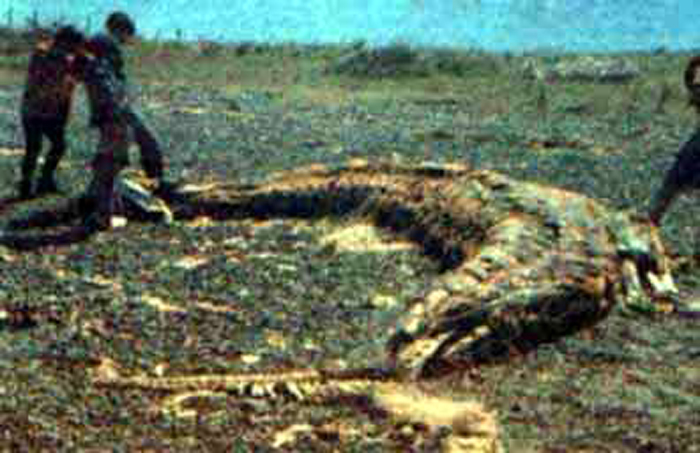
In 1922 this amazing creature washed up on a beach in South Africa. Although it looks somewhat like a crocodile, sources at the time said that it wasn’t, but an unknown sea monster with body armour!
There is a similarity here with a sea monster described in the historical book of Job in the Bible, called the Leviathan. Many of them inhabited the sea and had a serpentine look or image. It is described as a huge beast with scales so tight that air could not come between the sealing of the scales which were impossible to pry apart.
Source – http://powerpointparadise.com/livedragons/evolutio.htm
The Pensicola Harbor Attack – March 24, 1962
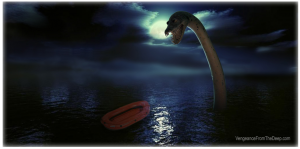
One of the more frightening personal encounters with a sea monster was relayed by teenaged Edward Brian McCleary, who said that his nightmare story began on the pleasant Saturday morning of 24 March 1962 in Pensacola Bay, Florida. McCleary and 4 friends – Eric, Warren, Brad and Larry – had been skin diving near the sunken “Massachusetts” when a sudden storm sent them into the ocean.
After the squall had let up, a heavy fog settled over the sea, and the 5 boys clung desperately to their rubber raft. The mist seemed filled with the odour of dead fish. Then, about 40 feet away, they heard a tremendous splash. Waves reached the raft and broke over the side.
Whatever it was, the boys knew that no boat had made the sound. They heard another splash, and through the fog they could make out what looked like a 10-foot pole with a bulbous head on top. It remained erect for a moment, then bent in the middle and dove under the surface. A sickening odour filled the air.
From out of the fog came a strange, high-pitched squeal. The 5 young men panicked, slipped on their fins, and decided to keep together and swim for the portion of the wrecked “Massachusetts” that remained above water. In the back of them, as they swam, they could hear splashing and a strange hissing sound.
McCleary remembered hearing a terrible scream that lasted for nearly half a minute. “I heard Warren call, ‘Help me! It’s got Brad! I’ve got to get outta here – ” Then Warren’s voice was cut off abruptly by a short cry.”
The 3 remaining swimmers clustered together not knowing how many feet of ocean separated them from the ghastly creature down there waiting for them.
Larry was the next to disappear. One minute he was there beside them, the next he was gone. The 2 boys dove for their friend but found nothing. Eric got a cramp in his leg. McCleary wrapped his arms around Eric’s neck and they continued toward the wreck. A wave broke, separating them when McCleary surfaced, he saw Eric swimming ahead of him. What happened next is the sutff of which lifelong nightmares are made of.
“Right next to Eric that telephone-pole-like figure broke water.” McCleary stated later to the authorities. “I could see the long neck and 2 small eyes. The mouth opened, and [the monster] bent over. It dove on top of Eric, dragging him under. I screamed and began to swim past the ship. My insides were shaking uncontrollably.”
Somehow the teenage boy managed to swim the remaining 2 miles to shore. He later recalled fragmentary images of sprawling on the beach, stumbling to a tower of some sort, and falling on his face before a group of boys. When he regained consciousness, he was in the Pensacola Naval Base Hospital.
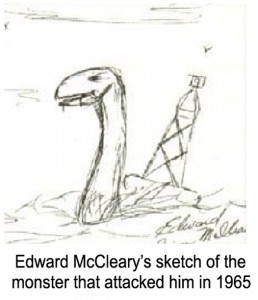 None of the reporters told all the facts of his escape from the hideous sea beast that took the lives of his 4 friends. Each of the various local newspapers carried the story of the tragedy, but they all attributed the boys’ death to accidental drownings. McCleary was told that his story about the sea serpent was best left unmentioned.
None of the reporters told all the facts of his escape from the hideous sea beast that took the lives of his 4 friends. Each of the various local newspapers carried the story of the tragedy, but they all attributed the boys’ death to accidental drownings. McCleary was told that his story about the sea serpent was best left unmentioned.
It remained for Edward Brian McCleary to write his own accoun for “Fate”, a small circulation magazine that specialises in stories of the strange, the unusual and the unknown. In his article (May 1965) he asked E.E. McGovern, the director of the search and rescue units, if he believed that the boys had been attacked by a sea monster. “People don’t believe these things because they are afraid to,” McGovern admitted. “I believe you but there’s not much else I can do.”
Source – http://www.cryptomundo.com/bigfoot-report/florida-hungry-sea-serpent/
http://answers.yahoo.com/question/index?qid=20060614234017AAZP1fi
The Alvin Plesiosaur Sighting – July 20th, 1965
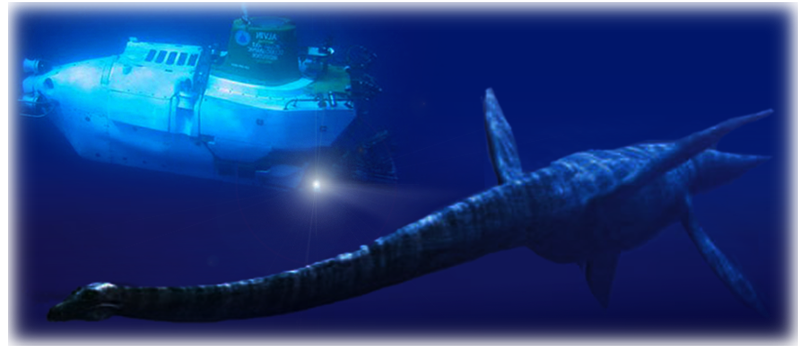
A riveting account of an encounter with a possible living plesiosaur was mentioned in Charles Berlitz’s 1977 book, “Without a Trace” in which submarine pilot Captain Marvin McCamis claimed to have seen an animal which looked like a plesiosaur in the deep waters near Grand Bahama Island on July 20th, 1965 when they were making their first 6,000-foot (1,800 m) dive in the Naval Deep Submergence Research Vessel ALVIN for the Navy to obtain certification.
Dale Drinnon over at Frontiers of Zoology reported that Scott Mardis, a leading Champ researcher who has worked in the vertebrate paleontology department of the Philadelphia Academy of Natural Sciences, had shared a sketch based off of Captain McCamis’ report on Facebook.
Source – http://cryptidchronicles.tumblr.com/post/50083859661/the-alvin-plesiosaur-sighting
The Monongahela Monster – January 13, 1852
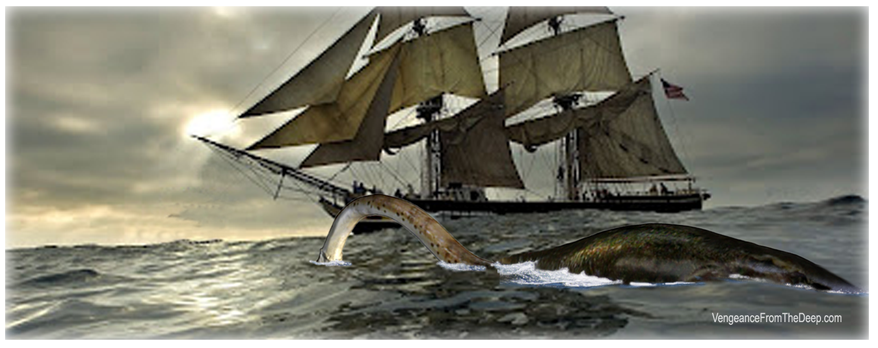
On January 13, 1852, while in latitude 3° 10’S and longitude 131° 50’W the whaling ship Monongahela of New Bedford encountered an enormous serpentine creature longer than the 100-ft. ship itself, and just under 50 ft. in diameter, with a 10-ft.-long alligatorlike head whose jaws contained 94 teeth (each approximately 3 in. long and recurved like a snake’s).
During a titanic struggle, the ship’s sailors sought to capture their monstrous visitor by harpooning it; the next morning its lifeless carcass, brownish-yellow and 103 ft. 7 in. long, rose to the surface of the sea. Although giant snakes are not believed nowadays to be responsible for any of the various different types of sea serpent reported over the years, this particular specimen did possess some distinctly ophidian characteristics, including its recurved teeth, a lower jaw whose bones were separate, and two lungs of which one was notably larger than the other. However, it also exhibited some highly un-snakelike features, such as a pair of whale-like blowholes, and four paw-like projections of hard, loose flesh.
Taxonomic considerations notwithstanding, it was clearly impractical to attempt to preserve the gigantic creature’s entire carcass–so the sailors hacked off its ferocious-looking head, for retention as absolute proof of this astonishing beast’s reality. The Monongahela’s master, Captain Charles Seabury, prepared a detailed account of the whole incident, including a full description of the creature itself; on February 6, the Monongahela encountered the brig Gipsy, journeying to Bridgeport, so Seabury handed his account to the Gipsy’s master, Captain Sturges, who promised to hand it into Bridgeport’s post office when the Gipsy arrived there. Presumably he kept his word, because newspaper accounts of Seabury’s report appeared, including one in the London Times for March 10, 1852.
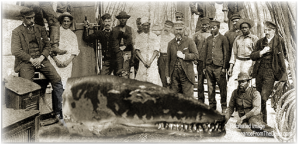 And this is where, for over a century, the story ended–because nothing more was heard of either the sea serpent head or the Monongahela carrying it. Accordingly, some cryptozoologists discounted the whole affair as an elaborate hoax–until 1959, which saw the publication of Frank Edwards’ book Stranger Than Science. This revealed that the ship carrying back Seabury’s account had actually been the Rebecca Sims, with a Captain Gavitt as its master, and that Seabury’s Christian name was Jason, not Charles. In addition, Edwards had learned that many years after Seabury’s account had hit the headlines, the name board of the Monongahela had been discovered on the shore of Umnak Island in the Aleutians. So what had happened to the ship? As no other trace of it has apparently been found, if the incident was indeed genuine did some catastrophe occur during its continuing voyage that consigned the Monongahela and its entire crew to the bottom of the sea–thereby returning its unique cryptozoological cargo from whence it had come, the unknown ocean depths?
And this is where, for over a century, the story ended–because nothing more was heard of either the sea serpent head or the Monongahela carrying it. Accordingly, some cryptozoologists discounted the whole affair as an elaborate hoax–until 1959, which saw the publication of Frank Edwards’ book Stranger Than Science. This revealed that the ship carrying back Seabury’s account had actually been the Rebecca Sims, with a Captain Gavitt as its master, and that Seabury’s Christian name was Jason, not Charles. In addition, Edwards had learned that many years after Seabury’s account had hit the headlines, the name board of the Monongahela had been discovered on the shore of Umnak Island in the Aleutians. So what had happened to the ship? As no other trace of it has apparently been found, if the incident was indeed genuine did some catastrophe occur during its continuing voyage that consigned the Monongahela and its entire crew to the bottom of the sea–thereby returning its unique cryptozoological cargo from whence it had come, the unknown ocean depths?
As with so many other cases on record within the ever-increasing chronicles of the sea serpent, the chances are that we will simply never know.
source – http://www.strangemag.com/seaserpcarcsshuk.html
The Moore Beach Monster – 1925
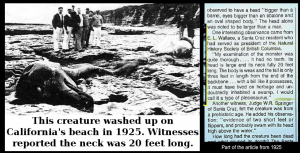
Mr. E.J. Lear gave an account about an unknown sea creature to the Santa Cruz Sentinel in 1925:
“I was driving a team toward Capitola, when suddenly I was attracted by some young sea lions not far out. They were lined up and several large lions were swimming back and forth in front of them. Much farther out I saw the water being churned to foam and thrown high up in the air. It was shiny and I took it for a big fish. A dozen or more lions were battling it, and every once in a while all would raise out of the water. It looked to me as though all the sea lions were attacking it beneath as the monster came out of the water several times. In telling of the battle of that night I estimated its length at 30 feet.
“The battle continued as long as I could see it from the road. I was driving toward Capitola with a load of sand. I have not seen the monster on the beach, but it may have been that which I saw.”
An actual modern day monster?
A few days later the body of a strange creature was discovered by Charles Moore on the shore in the very same area that Mr. Lear saw the battle. The body was examined by a naturalist, E. L. Wallace who said “My examination of the monster was quite thorough. I felt in its mouth and found it had no teeth. Its head is large and its neck fully twenty feet long. The body is weak and the tail is only three feet in length from the end of the backbone. These facts do away with the whale theory, as the backbone of a whale is far larger than any bone in this animal. Again, its tail is too weak for an animal of the deep and does away with that last version. With a bill like it possesses, it must have lived on herbage…I would call it a type of plesiosaurus.”
“Later, Mr. Wallace offered the theory that the monster may have been preserved in a glacier for millions of years, finally being released by the gradual melting of ice, eventually ending up cast upon the shore in Monterey Bay.”
source – file:///Users/russ/Desktop/cryptid%20sea%20monsters%20%7C%20The%20Paranormal%20Effect.webarchive
Esquire Magazine Report of San Clemente Monster – 1934
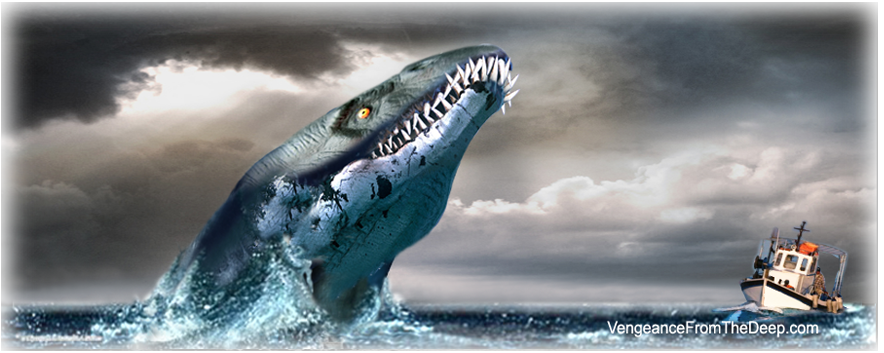
Believe it or not, Southern California’s San Clemente was once a sea serpent haven. The June 1934 issue of Esquire Magazine For Men featured an intriguing article by a Ralph Bandini who spoke quite openly of his two encounters with the San Clemente Monster. In his article “I Saw A Sea Monster,” Bandini commented, “San Clemente Island is a lonely, wind-swept bit of rock and sand lying some fifty miles south of Los Angeles Harbor. It is little frequented except by fishermen. Its waters are lonely too…The Thing itself appears to like this remote bit of ocean – that windy channel between San Clemente and Santa Catalina.”
During the early 1900s there were rumors that a strange creature was roaming the Avalon waters, and that some thirty people had seen the monster, but spoke little of it. Baldini was tuna fishing in the southern Californian channels when he first spotted the leviathan. He was ten miles off Catalina when the beast emerged from the water about a mile away. It was no whale. No sea elephant. It was a monster. It was a glistening, dark beast that rose out of the water, and remained exposed for a minute or so before sinking majestically back into the depths.
Baldini chose not to speak of the sighting, despite the possibility of some publicity and small fortune. He respected others who’d seen the beast, and all witnesses he could track down sketched a monster that matched every other sketch he’d seen. Then, in the September of 1920 Ralph had a very close encounter with possibly the same form.
He was swordfish fishing with a Mr Smith Warren. They’d been positioned at Mosquito Harbor and were passing White Rock when something caught Baldini’s eye. Just three-hundred yards away he saw what he described as, “A great barrel-shaped Thing, tapering toward the top and surmounted by a reptilian head strangely resembling those of the huge, prehistoric creatures whose reproductions stand in various museums. It lifted what must have been a good twenty-feet. Widely spaced in the head were two eyes – eyes such as were never conceived of even in the wildest nightmare.”
These eyes were around a foot in diameter, like dinner plates, belonging to some great, hulking monster seemingly spewed from one of H.P. Lovecraft’s fictional terror tales. But this was real.
The men headed for the creature and got to within one-hundred feet. It appeared as though it was covered in short, dark bristles, and it had a reddish hue. All that protruded from the water was a huge neck and head. Goodness knows what length and mass lurked beneath the waves it frothed around it. And then it was gone…slipping back into the murky domain.
Only a few witnesses to the San Clemente sea monster remain today. Many have surely never spoken of the great beast, and others died with their secrets. However, what we do know is that out there, somewhere, there still may be one, two, or more sea serpents eluding science, and stirring the waves of legend.
source – http://laist.com/2009/01/11/weird_los_angeles_7.php
(or read the full article here)
Historical Note: I Saw a Sea Monster, by Ralph Bandini
From Esquire Magazine for Men, June 1934
(Thanks to Kevin Stewart for tracking this down.)
Have any of you ever seen a sea monster? No? Very well—I have!
It is an amazing story—and true in every detail. I am quite aware that it takes square issue with science. I have no illusions as to inevitable scepticism. Nevertheless, I know what I saw—and I tell it as I saw it.
Just at the moment sea monsters constitute what is known in newspaper parlance as “hot copy.” Almost any week in the daily papers, in Sunday supplements, in magazines, the reader can find some yarn telling of this or that strange creature seen in the sea. It is almost as though all the hidden monsters of the depths had suddenly taken it into their heads to pop up to the surface.
Of course there is nothing new in this matter of sea monsters. For hundreds, even thousands of years, sailormen have brought to port tales of sea serpents—but their stories have been scoffed at. Scientists have gravely declared that no such creatures exist. To a layman such certainty cannot help arousing wonder. We know that strange and monstrous forms of life existed on land when the world was young—and in the sea as well. Granted that the land creatures are long ago extinct by reason of revolutionary changes in living conditions, nevertheless, those same changes have not been so pronounced in the sea. It would not seem beyond the realm of possibility that some of them may have survived. For good and sufficient reasons, as will be seen, personally I believe they have.
Be all that as it may be, however, the fact remains that recently there seems to have been a sudden revival of these intriguing tales.
We have the serpentine creature allegedly seen by some hundred-fifty more or less reliable persons in Loch Ness, Scotland. There are those two with the Louisa Alcott names said to disport themselves off Juan de Fuca Straits. In Lake Okanagan, British Columbia, there is another one, sufficiently credited by the authorities that they offer facilities to anyone who will go after the thing in a spirit of true scientific research. Then, from Acapulco, comes that amazing story of the track of a great, three-toed creature coming up out of the sea and returning, all between tides; of the deep furrow plowed by its dragging tail; of the deep, barrel-like depression in the wet sand where it rolled and wallowed! I happen to know the man who saw those tracks. He is not a liar.
Quite probably some of the reported sea serpents—I do not mean those which I have specifically mentioned—are inventions pure and simple. Others may have been illusions. After all, a flight of low-flying birds along the horizon, bits of floating stuff (it’s queer the shapes that flotsam on the surface sometimes takes), might, in poor light, take on the semblance of an undulating sea serpent. However, one would not go far amiss to accept that queer creatures have been seen upon the face of the sea.
Now most of the above mentioned beasties, with the possible exception of the one near Acapulco, have been given wide publicity. However, there is still another, about which little or nothing has been told or written. This is that huge Thing sometimes called the “San Clemente Monster”—and monster it truly is if ever there was one! I have seen it—and I know whereof I speak.
San Clemente Island is a lonely, wind-swept bit of rock and sand lying some fifty miles south of Los Angeles Harbor. It is little frequented except by fishermen. Its waters are lonely, too. Days can go by when one will never see a boat. The Thing, itself, appears to like this remote bit of the ocean—that windy channel between San Clemente and Santa Catalina.
Just why so little has been said about so strange a resident of so publicity-minded a community as Southern California it is hard to say. Certainly it has been seen by enough persons—some twenty-five or thirty that I know of and many of whom bear reputations for veracity beyond reproach. Furthermore, it has been seen periodically over the last fifteen or twenty years. Perhaps this paucity of detail is mainly due to the fact that the Thing is so monstrous, so utterly incredible, so impossible, that any sane man shuns the incredulity with which his tale is inevitably received. In fact, I know this to be true. Some of my intimate friends have seen it. They know that I have seen it. Yet, despite friendship, despite this mutual knowledge of one another’s experience, I find most of them reluctant to talk, even to me. One interesting phase of the matter is this. Whenever I have been able to persuade one of these friends to do so, we have independently drawn sketches of what we saw. Barring differences in artistic skill these drawings show one and the same thing!
About fifteen or twenty years ago rumors began to be current around Avalon that there was something queer out in the Clemente Channel. There were guarded hints of some huge, unnameable Thing lifting up out of the sea. These rumors were shadowy, difficult to run down. No one credited with having seen the Thing would admit it. Still the rumors persisted. Perhaps the very evasiveness encountered was tantamount to admission.
I was out in the Southern California channels a lot during those days, fishing for tuna and swordfish. Naturally I heard about the Thing. Being by nature curious. I proceeded to ask questions—but learned nothing. My boatman, Percy Neale, an old timer at Avalon, was said to have seen it. I asked him. Percy looked out to sea—made some irrelevant remark—then, when pressed, muttered something about “eyes as big as dinner plates” and changed the subject.
Then came my first view of the Thing!
We were fishing for tuna about ten miles off Catalina in the Clemente Channel. It was a windy afternoon—the channel a welter of breaking seas. Suddenly Percy let out a yell.
“Look! Look! Over there!”
He pointed to seaward. I saw it! About a mile away something huge, wet and glistening, was lifting up out of sea! Higher and higher it raised until I felt my skin crawl. To this very day I vividly remember that queer, empty feeling in the pit of my stomach.
Why should I be scared! Just picture it for yourselves. A tumbled, broken sea, flecked with white, and stretching away to the horizon’s edge. Catalina looming through the golden haze of afternoon. San Clemente a vague shadow far to southward. Sea birds wheeling, hovering, darting. That monstrous Thing rising up out of the sea!
I don’t know how long he stayed up. Perhaps a minute—perhaps less. Fascinated, spellbound, we watched him. Then, before our very eyes, majestically, slowly, he sank back into the depths from whence he had come.
There was a scarcity of small talk aboard that ship from then on. Tuna fishing seemed to have lost a lot of its charm. Swiftly developed a multitude of perfectly good and sufficient reasons why we should forget further fishing for that day and go home early—leaving that particular bit of the world to whatever might care to claim it.
As we slipped up the coast toward Avalon through the quiet waters of the lee side—as we began to encounter other boats—to meet again man and his handiworks, the horror of what we had seen seemed to lessen and our tongues were loosed. We talked grandly about how we would go ashore and spread the wonder of what we had seen to the world at large—possibly make our everlasting fortunes out of it. But we did no such thing! Somehow or another, face to face with the orderliness of Avalon town, with the smug scepticism of the Tuna Club, we found our lips sealed. Words would not come. Instead we slunk furtively to the nearest bar and tossed down two stiff drinks.
Two or three years passed. Others saw the Thing. Some, braver than their fellows, talked. Little by little the earlier discoverers came out of their shells and talked, too. All accounts from those who had been really close to the Thing agreed upon three fundamentals: that it was enormous; that it possessed huge and horrible eyes; that it was something absolutely unknown to man. A composite description of the Thing was forwarded to the late Dr. David Starr Jordan of Stanford University. He replied by suggesting it probably was a sea elephant! Our descriptive powers must have been woefully weak. It was no more a sea elephant than I am. I have seen them, many of them—roaming around the sea—in their native rookery at Guadalupe Island. Sea elephants look like seals except that they are larger and have a prolonged, hooked upper nostril. This Thing was not a sea elephant nor did it remotely resemble one.
Then came my second and only close-up view of the Thing!
It was in September, 1920. I was fishing for marlin swordfish at San Clemente with the late Smith Warren. We were staying at Mosquito Harbor where the fish camp used to be. It was early in the morning—about 8:00 o’clock. We had worked close in shore the three miles from the camp down to the East End. We had then turned back up the coast and worked along about a mile and a half to two miles off shore. The sea was glassy with just a little roll coming down the island. Overhead it was overcast—one of California’s summer fogs. Objects on the surface showed black in that light. The brown slopes swept up abruptly to almost meet the gray mist. We passed Mosquito and the white tents of the camp and were nearly abreast of White Rock. Smithy was down in the cockpit doing something or another. I was perched on top of the cabin looking for fish. My bait trolled along astern, the rod tied to the fishing chair.
Suddenly, out of the corner of my eye, I caught a glimpse of something huge lifting up out of the sea. Turning swiftly I was face to face with something I had never seen before—will probably never see again!
Here it is—just as I saw it. Take it or leave it.
A great barrel shaped Thing, tapering toward the top and surmounted by a reptilian head strangely resembling those of the huge, prehistoric creatures whose reproductions stand in various museums. It lifted what must have been a good twenty feet. Widely spaced in the head were two eyes—eyes such as were never conceived of even in the wildest nightmare! Immense, at least a full foot in diameter, round, slightly bulging, and as dead looking as though they had seen all the death the world has suffered since its birth! No wonder those who had seen it close by could speak of little else but the eyes!
This was the picture that came into the lenses of my seven power binoculars the moment I clapped them on to the Thing—knowing what I was looking at. At the same time I yelled to Smithy to head for it.
Through the glasses the head, those awful eyes, that portion of the body showing—and it must have been at least six feet thick, perhaps more, appeared scarcely a hundred feet away. It was covered with what looked like stiff, coarse hair, almost bristles. Strangely enough, considering the light, I gained a distinct impression of a reddish tinge. Remember that.
The bulk of the Thing simply cannot be told. To this day I don’t believe that I saw anything but the head and a section of the neck—if it had a neck. What was below the surface only God knows. But listen to this. You will recollect that I mentioned a little roll coming down the island? The Thing did not rise and fall in that roll as even a whale would. The waves beat against it and broke.
As we drew nearer, the great head which had been slowly turning, stopped. The huge, dead eyes fixed themselves upon us! Even today, after fourteen years, I can still see them—yes—feel them. For seconds—it seemed like hours—they stared at us incuriously, dull and lifeless. Then, without convulsion of any sort, it started to sink, slowly, majestically—and disappeared beneath the surface. There was no swirl, no whirlpool, no fuss, no nothing. The waters closed over it and it was gone.
With its disappearance I think we breathed for the first time. I looked at Smithy—Smithy looked at me.
“J——!” I croaked.
He threw out the clutch and we lay to—staring at the empty sea. I was wringing wet and my knees shook. Smithy, normally a voluble man, was speechless. Mechanically he stooped down and picked up a little piece of wire leader from the cockpit floor, tossing it overboard. Around us was the same gray sea, the same sea birds, the same lonely, brown-sloped island. Overhead was the same gray fog. But everything was different. All the friendliness had gone. We, two frail humans, had looked into the eyes of the Past—and looking was not good.
Only a week later I was talking to N. B. Schofield, head of the Bureau of Commercial Fisheries of the California Division of Fish and Game. Schofield is an ichthyologist of considerable reputation and a pupil of the late Dr. David Starr Jordan. He suggested that I was said to have seen a strange monster and asked me about it. After I had described the Thing he was silent for a minute or two then went on to say that fishermen out of Monterey, California, swore that they had been seeing a similar creature only recently.
So frightened were some of them at what they had seen that they refused for days to go to sea. I drew a sketch of the Thing which Schofield pocketed to show to them. I haven’t heard whether or not they identified it as one and the same thing. Mind you, Schofield in no wise accepted my story or theirs.
From my own experience and from those of others I will say unequivocally that the Thing is very shy.
I was never closer to the Thing than three hundred yards—perhaps more. I know two men who have been closer than that but there is no material variance in their stories and mine other than one of them thinks he saw a mouth with teeth. I am quite sure that I did not.
As to how large the Thing is—your guess is as good as mine. I have a feeling, probably a sort of sixth sense, which tells me that I saw only a small portion of the beast—that beneath the surface was a body greater than that of any known creature, a whale included. However, that is nothing more than an unprovable hunch. I do not know whether it was serpentine in form or not. I again have a feeling that it was not. If it was—then we had better revise our views on serpents.
I have told all I know about the Thing. Now, I will lay all my cards face up upon the table. Smith Warren is dead; his lips are sealed. Neale is still living but was never as close to the creature as were we. True, there are a number from out of the ranks of those twenty-five or thirty who have seen the Thing who are still alive. Some of them might come forward in defense of my story—but I shall not ask them to.
I shall never ask any man to put his neck into a noose of ridicule on my behalf. There is one man who has been closer to the Thing than any of us—but he refuses point blank to talk, even to me.
So—there you have it. Just as I wrote earlier—take it or leave it. It is all one to me. Smile if you want to—laugh if you want to. I have taken it before—I can take it again. But, when you laugh, if you do—just remember those old immortal lines— “There are stranger things,” etc. Also, remember one other thing. You have not been out alone upon the sea and seen a monstrous Thing lift up out of the depths and close beside you—you have not felt the baleful stare of those awful eyes—you have not sensed the cold breath of ages past upon you. I have—and that’s that. Adios.
source – http://www.strangeark.com/bfr/historical/san-clemente.html


